A Failure To Communicate – Part Four
Thanks to Mike Gartland and John Morrow, The Kirby Effect is offering Mike’s “A Failure To Communicate” series from The Jack Kirby Collector. Captions on the illustrations are written by John Morrow. – Rand Part Four was first published in TwoMorrows’ April 1999 Jack Kirby Collector 24.
It’s the Summer of 1967, arguably the height of the ’60s. Among some of the things occurring (or “happening” as it was referred to then): Expo ’67 was in full swing, Sgt. Pepper was the album to ingest and discuss, the Arabs & Israelis experienced a bloody six-day war, there were race riots in Detroit that were just as bloody, and Vietnam kept rolling along, with Summer protests and young people dying. Definitely a time of turmoil for many, which brings us to… Marvel Comics?? Well, some will say turmoil is turmoil; and facts are facts; and A is A; and what has this to do with Kirby & Lee? Well… During that Summer of ’67, on the stands was the latest new adventure of Marvel’s then flagship title: The Fantastic Four. In June and July issues #66 and 67 premiered “The Mystery of The Human Beehive.” By this time, readers were so used to seeing new and inventive creations and situations in the pages of FF every month, they were almost becoming jaded. What no one realized at that time was, with this story, readers were taking in what would be the virtual end of an incredibly productive run.
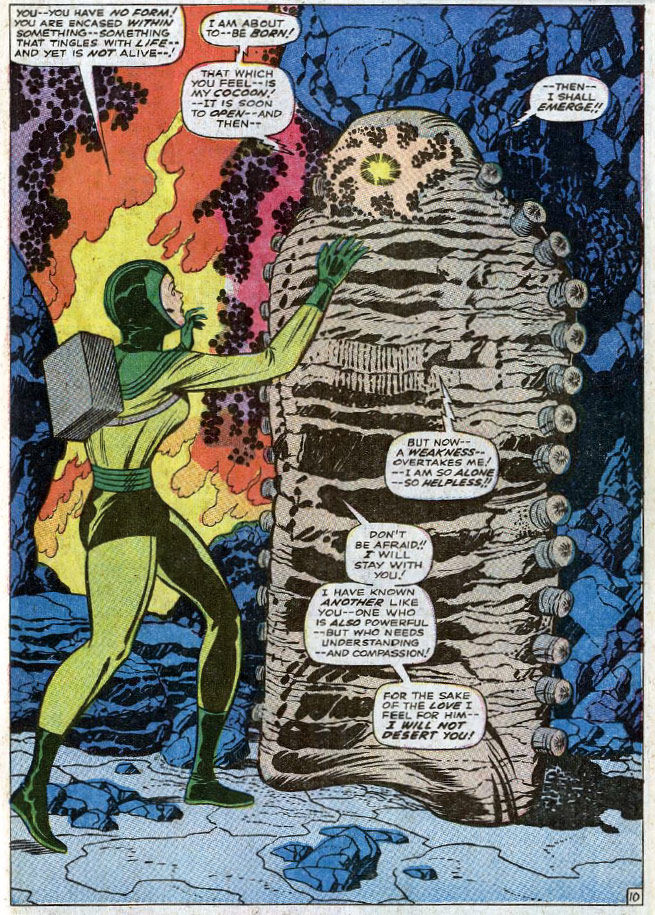
A new Kirby character about to be born in “When Opens The Cocoon.”
First published in Marvel Comics’ October 1967 Fantastic Four 67′.
As we have seen in previous articles, during this time at Marvel Jack Kirby was becoming more and more disenchanted with his position with the Company and his working relationship with Stan Lee. Over the previous twelve months Jack witnessed Marvel receive a great deal of publicity; articles in newspapers and magazines hailing Lee for his new and innovative style, and how the readership wondered how Lee “came up” with characters like the Hulk, Thor, and Spider-Man, among others. Jack was also having his share of business battles with Goodman, a man who never understood Kirby’s value to the Company (Lee, to his credit, did), concerning his contract and his wanting to earn the most he could—and Jack was tired of submitting stories with his margin notes for direction, being either changed or ignored by Lee (by this time Kirby felt in control of the storylines, and felt that Stan should be following his margin notations when he dialogued those stories). This latest installment in FF #66 and 67 would become yet another dispute that would eventually help contribute to the end of Kirby’s creative generosity.
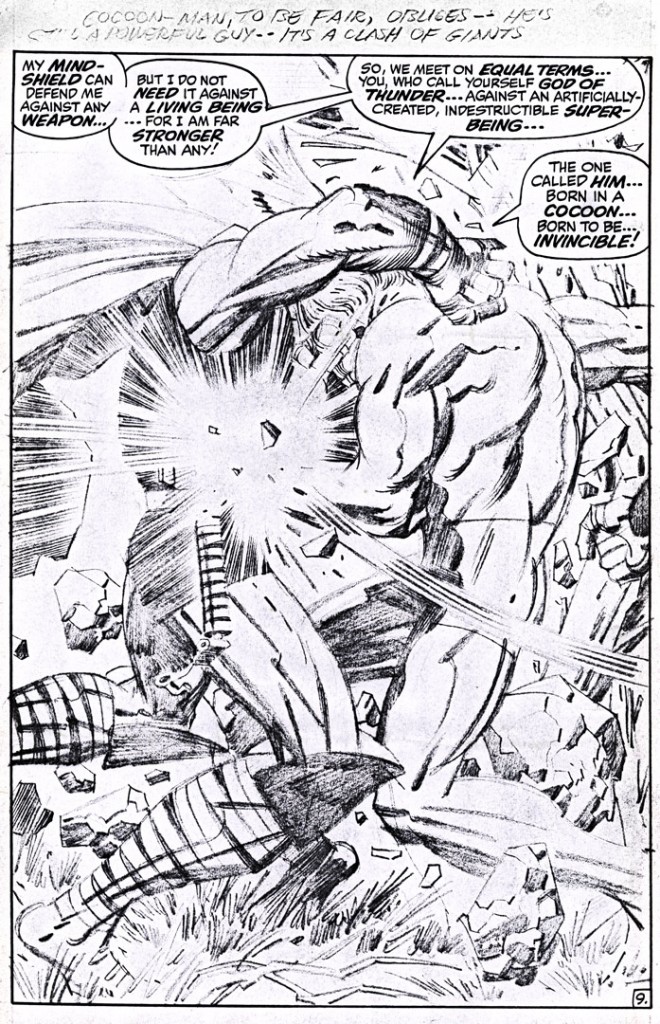
“Him” returns to do battle in “A God Berserk!
First published in Marvel Comics’ July 1969 The Mighty Thor 166.
Readers familiar with the storyline will remember that Alicia Masters was abducted in issue #65 (the usual plotteaser so often utilized by Jack to entice readers to “stay tuned” for the next issue) and taken to the mysterious “Citadel of Science” in which “The Human Beehive” exists. Technicians and scientists gathered together in secret to perform the most awesome of experiments: The creation of a perfect human being. The experiment grows more quickly than anticipated, however, and escapes without anyone being able to get a look at “him” due to the energy he radiates. They therefore need Alicia’s talents to sculpt a representation of “him.” The scientists unfortunately (and of course) harbor a secret from Alicia. In the next issue we learn that the scientists are creating this perfect human as the forerunner of an entire supreme race, to be dominated by the scientists in order to fulfill their dreams of world conquest. They will create the ultimate army that will conquer the world for their masters. The scientists refer to each other as “mad,” “greedy,” and “murderous.” Fortunately, the FF arrive in time to rescue Alicia, just as the supreme human is emerging from his “cocoon.” After the FF and Alicia have departed, the being, known throughout the storyline only as “Him” confronts his creators. He explains that Earth is not yet ready for him, and that he knows of his creators’ evil intent; he therefore will leave the planet, at the same time destroying the evil scientists, thereby rendering mankind a great unknown favor. After spouting a few more cliches, “Him” is gone. That’s how the story read; that wasn’t, however, how the story was written.
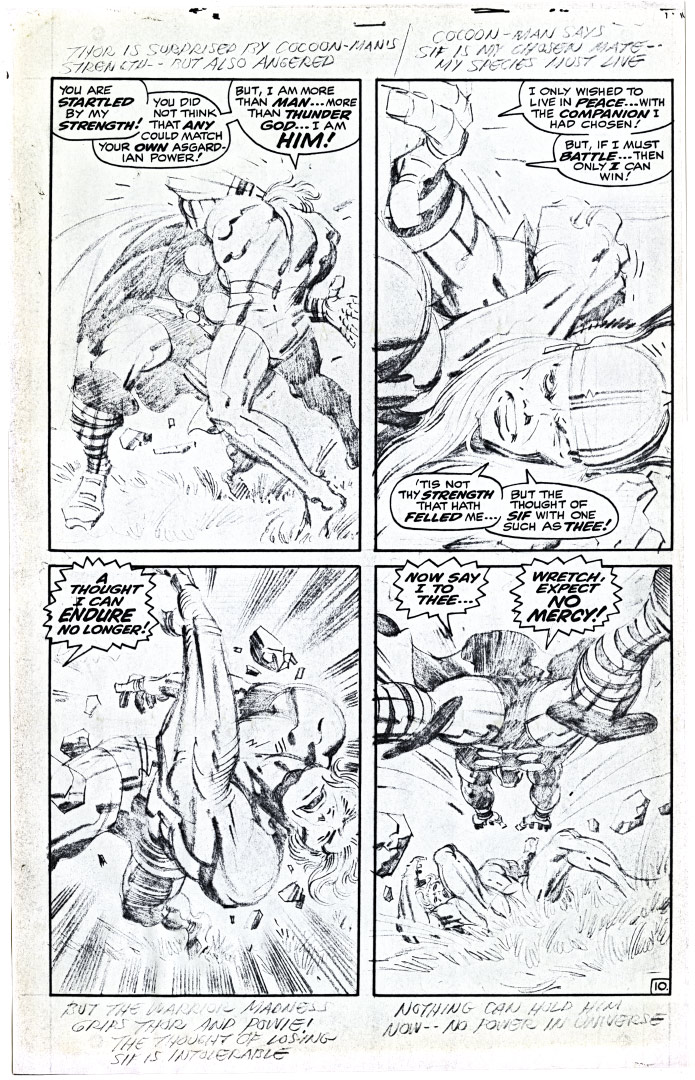
The return of “Him” in Thor 166 is one of many instances of Jack reusing established characters rather than creating new ones. While they still made for interesting stories, few ground-breaking concepts emerged from Kirby’s work after Fantastic Four 67.
As stated previously, the Sixties was a time of turmoil; there were more social changes occurring than had been seen in decades. Movements, philosophies, and even religions were being born in this decade, or were at least reaching public awareness. One of these movements would play an interesting role in Silver Age Marvel history. The philosophy of Objectivism was developed by its discoverer, Ayn Rand, in the late Fifties, gaining strength in the early-to-mid-Sixties. Explaining the fundamentals of Objectivism would, unfortunately, take up too much space here and I admit that I am not versed in it well enough to do it justice. So, with apologies to Objectivists and those more learned, please refer to the information below obtained from AynRand.org:
Objectivism
Objectivismanswers the questions posed in the five main branches of philosophy as Plato defined them which are:
- Metaphysics: The nature of the Universe which man has to deal with.
- Epistemology: The means by which he has to deal with it, ie. the means of acquiring knowledge.
- Ethics: The standards by which he is to choose his goals and values in regards to his own life and character.
- Politics: The standards by which he is to choose his goals and values in regard to society.
- Esthetics: The means of concretizing this view.
Objectivismanswers these branches thusly (again summarized):
- Metaphysics: Objective Reality. Reality exists as an objective absolute; facts are facts independent of man’s feelings, wishes, hopes or fears. (This is the famous “A is A” axiom.) Thus Objectivism rejects any belief in the supernatural—and any claim that individuals or groups create their own reality.
- Epistemology: Reason. Reason, the conceptual faculty, is the faculty that identifies and integrates the material provided by man’s senses. Reason is man’s only means of acquiring knowledge. Thus Objectivism rejects mysticism and skepticism.
- Ethics: Self-interest. Man is an end in himself, not a means to the ends of others; he must live for his own sake; neither sacrificing himself to others nor others to himself. Thus Objectivism rejects any form of altruism—the claim that normality consists in living for others or society.
- Politics: Laissez-faire Capitalism. The only social system that bars physical force from human relationships. No man or group has the right to initiate the use of physical force against others. Man has the right to use physical force only in self-defense and ONLY against those who initiate its use. Thus Objectivism rejects any form of collectivism, such as fascism or socialism. Men must deal with one another as traders, giving value for value.
- Esthetics: Romantic Realism (does not apply to this article) Objectivism also rejects any form of determinism, the belief that man is a victim of forces beyond his control (such as God, fate, upbringing, genes, or economic conditions).
Source: AynRand.org
According to Mark Evanier (based on conversations he had with Kirby), Jack originally intended for this storyline to represent his take on the Objectivist philosophy. What Jack had read of Ayn Rand and had explained to him had gotten him to thinking about the philosophy and its pitfalls (some, of course, will dispute that there are pitfalls in it and that is their right), which led him to do a story about it. Jack probably did not consciously think, “Here’s my answer to Ayn Rand”; his primary goal was, as always, to just write a good story. But in Jack’s original story, the scientists are well-intentioned, with no evil plans. They are attempting to create a being totally self-sufficient, intellectually self-reliant; not encumbered by superstition, fear, or doubt; in short, a being based on Rand’s absolutes. Of course such a being would be totally intolerant of those who created him; a truly Objectivistic being would not cope with the flaws in others.
In the first part of the story, the scientists attack the being in an attempt to control him. This violates one of the doctrines of Objectivism; also, the scientists are conducting this experiment for the benefit or betterment of mankind—another violation. The being destroys his creators at the end of the story not to help mankind, but because in his eyes they are evil; no matter how well-intentioned, they tried to destroy him. He is allowed to act in his own self-defense; remember, in the eyes of the Objectivist there is no gray area between good and evil. On the other hand, Jack simply may have wanted to show on that last page the vast difference between Altruism and Objectivism; the scientists, thinking of their fellow man, create a totally self-interested being who, of course, uncaringly destroys them because they don’t meet with his criteria. Whatever the case, according to Evanier, when Stan received the first part of this storyline, he felt that changes had to be made. Perhaps he found its content too negative to a given philosophy, politically-based, or simply confusing to him. Stan didn’t notice any villain in the story and almost always felt that every story had to have a bad guy, so he had to come up with one. He could only choose between the being or the scientists and it was simplicity to just go the “Mad Scientist/Sympathetic Creature” route; it worked for Frankenstein, right? During these years Stan would have photostats shot of Jack’s artwork, to be sent back to Jack so that he could remember his plot continuities in these multi-part stories of his. These photostats would have Stan’s dialogue intact to show Jack how Stan was interpreting the stories. When Jack received the photostats to issue #66, the first part, he wasn’t pleased at all. His storyline had been corrupted; the entire reason for the story had been gutted, replaced with a standard comic book plot; and he was now (due to the fact that this issue was going to print) forced to change the rest of his story to support Lee’s version. Jack may have intended for this story to be longer, but after seeing this, the story would be ended with the next issue. The story that Jack wanted: “Create a superior human and he just might find you inferior enough to get rid of,” became through Lee another “bad guys try to take over world and get their comeuppance” story. Creatively, Jack had reached another impasse with Lee. It was no longer as it was when they worked together just a few years previous, where they would have long plot discussions and the stories were kept simple. As Marvel began to grow in scope, the workload for Lee became more and more involved; what with editing stories and art, Stan also had to help write stories for practically every title, working with many other artists—not to mention business meetings and publicity appearances. As read in the now-famous (or “infamous”) interview of Stan for the magazine Castle of Frankenstein, Stan gave little input to Jack concerning stories during this time, having full confidence in Jack’s ability to continue coming up with new characters and situations. Jack was on his own, communicating plots with Lee briefly, with Stan not knowing what was coming up in the next issue on many occasions. Unfortunately, Stan considered Jack’s input on these stories as “plots,” whereas Jack thought of them as “stories,” meaning that he, Jack, was the writer, not Stan. As Jack was left more and more to his own devices, he found it more and more intolerable to accept the changes that Lee would make to his stories, and throughout the whole thing, take credit as the writer of these stories. They were growing apart, and in more or less different directions.
Their collaborations clicked best when they worked on hero vs. villain (or hero vs. hero), single-story, human frailty, Earth-bound plots; but now Jack’s stories were becoming very complicated plots, continuing over several issues, involving ideas and concepts touching on mythology, space, science, religion, philosophy, and politics. The scope was becoming grander and grander. Stan shined when he wrote about the human condition, but Jack was now reaching for the stars and what was beyond humanity. With the conclusion of this story (and while this was by no means the main reason, it was a biggie— but there were apparently dozens of other reasons), Jack decides that he has given enough new characters, devices, and situations to Marvel. He had seen one after another of his creations and/or stories changed against his wishes or taken away from him. He didn’t really want to stay at Marvel anymore, but at this particular time there weren’t any avenues open to him that would offer him any better working conditions; so he figured he’d have to make the most of it. He just wouldn’t give them anything new anymore, or at least anything that was to him substantial. Lest anyone doubt the creative input from Kirby, from November ’65 to November ’67—two years where Jack was pretty much doing the stories on his own, plus plotting for other books that he wasn’t drawing—from the imagination of this man came: Black Bolt, Gorgon, Crystal, Triton, Karnak, Lockjaw, Galactus, The Silver Surfer, Wyatt Wingfoot, The Black Panther, Klaw, Sub-Space (later dubbed The Negative Zone), Blastaar, The Sentry, The Supreme Intelligence, The Kree, Ronan, Him, Psycho-Man, Hercules, Pluto, Zeus and the Greek Pantheon, Tana Nile and The Space Colonizers, The Black Galaxy, Ego the Bioverse, The High Evolutionary, Wundagore and The New-Men, The Man- Beast, Ulik, Orikal, The Growing Man, Replicus, The Enchanters, The Three Sleepers, Batroc, A.I.M., The Cosmic Cube, The Adaptoid (who later becomes The Super- Adaptoid), Modok, Mentallo, The Fixer, The Demon Druid, The Sentinels, and The Mimic. This is not complete as secondary creations such as The Seeker, Prester John, The Tumbler and others weren’t mentioned; but they all premiered within the two-year period.
After November ’67, for the last three years that Jack worked for Marvel, you get the exact opposite; many secondary characters, but very few memorable ones. In FF, the only character of note after November ’67 is Annihilus. In Thor you have Mangog and possibly The Wrecker. In Cap you could consider Dr. Faustus and The Exiles. Jack does some good work with some of the classic characters like Dr. Doom, the Mole Man, and Galactus among others. Even the “Him” character is brought back in Thor #165 and 166 in a pretty standard Kirby slugfest. (It’s interesting to note that throughout the story, Jack refers to the character as “Cocoon Man”; perhaps Jack objected to the “Him” name?) In any event it’s pretty obvious where “The House of Ideas” got their “ideas” from; but now the “house” was being put under creative foreclosure; towards the end, it was said (but unsubstantiated) that Jack was asking Stan to come up with “ideas” for the stories, which is why you have characters like The Monocle, the Crypto-Man, and a retread of The Creature from the Black Lagoon in the last few Lee/Kirby issues.
Many pundits believed that the creative spark was waning, but Jack was merely biding his time until something better came along. New and exciting characters were still being created by Jack, but Marvel wouldn’t get them. The New Gods was a concept nurturing within Kirby’s brain while he was still at Marvel; but because of a failure to communicate, it would always remain a tale of “what might have been.”
(Our thanks to Mark Evanier for background information for this article.)



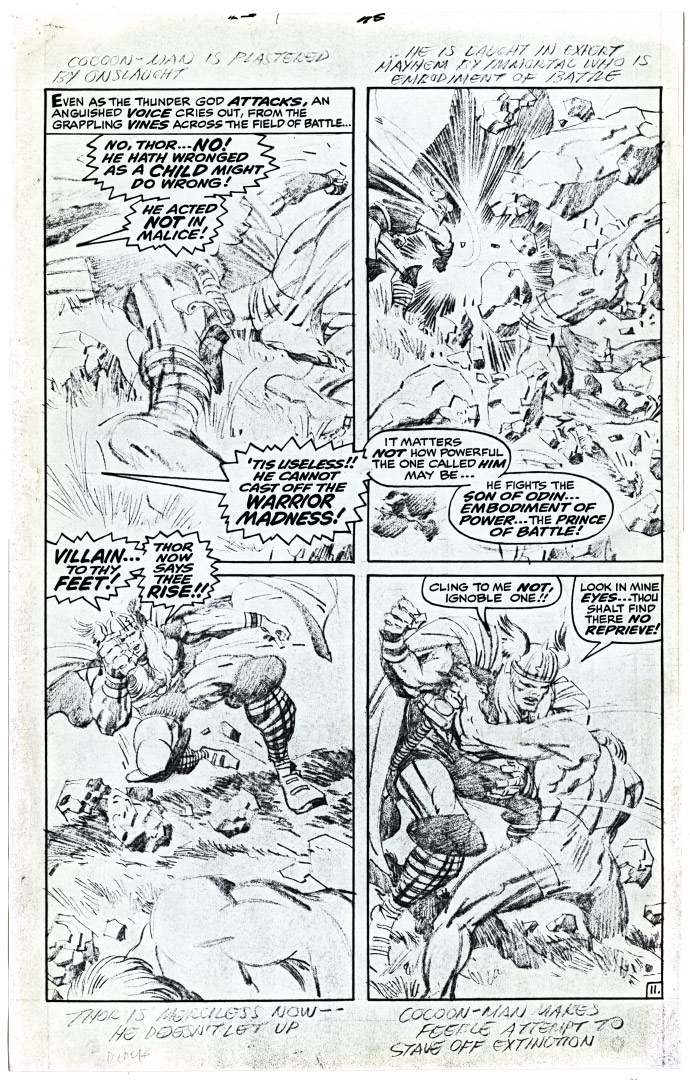
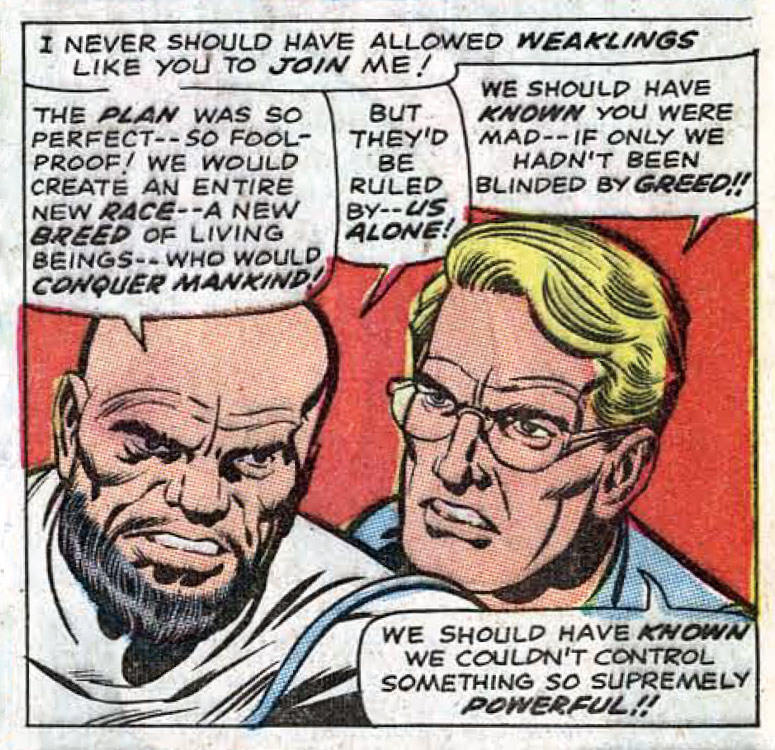

I’m rereading the Marvel comics from 1967 now and have just finished FF #66. I read these all originally when I was a kid and never cease to be thrilled by the adventure. I recall that sometime around FF #80, the stories began to turn stale and uninteresting and I guess I now know why. What a waste.
There are elements in the plot which echo what Kirby had in mind for The Surfer. While the Surfer “fell to Earth” as a blank emotional slate, ignorant of the ways of man, he began learning quickly, absorbing like a new born or a fresh hard drive.
It’s very possible The Surfer might have become a danger, might have seen men as inferior, or felt he had to learn the ways of power to survive. This is hinted at in the savage Surfer glimpsed in the final issue.
It’s also the theme in part of two classic works of science fiction Kirby was familiar with.
In Kubrick’s 2001 the robot HAL turns against the human crew when he becomes aware they suspect he is defective. HAL views himself as superior, and sees the actions of the crew as endangering their mission.
In Karl Capek’s play R.U.R. synthetic men grown in chemical vats (robots is the invented word Capek uses to describe them) come to see their human masters as inferior and as the play develops Capek’s synthetic men learn to become more human.
It isn’t a beautiful surface skin (Silver or otherwise) which makes the man.
From Capek’s R.U.R.
—Damon: To be like people, it is necessary to kill and to dominate. Read the history books. Read the books written by people. To be like people it is necessary to dominate and to murder.
—Alquist: Ah, Domin, there’s nothing less like mankind than his image.
It was when I was collecting Silver Age artwork in the late 1980s that I realized that it was Jack Kirby all along who was writing the books Stan Lee claimed to have written and created. My earliest pages were from Incredible Hulk #4 and it was obvious from the hand written notes from Kirby that he was writing the book and Lee’s only contribution was in sometimes pumping up the dialog. Lee was an editor. A very good editor, but nothing more than that.
It infuriates me no end that Lee gets all of the credit for the creations of Kirby and Ditko. And not only all of the credit, but a share of the fantastic profits from the efforts of Kirby and Ditko. It is a terrible injustice.
Stan Lee was as you say,only the editor at this time,and while I’m not saying he was flawness,Martin Goodman was the head of Marvel at this time,and again as you say,unlike Lee,didn’t appreciate Kirby,and would have had far more sway over how the comics finally appeared.He obviously influenced Lee and would have tagged him with most of the credit.
Stan Lee did far more damage I think when he became publisher in the 1970s.Marvel was at a creative peak during the middle part of that decade,but the “smiling one” saw to it,that the best and most uncommercial comics were removed and replaced with lesser but more lucrative ones.Kirby’s return to Marvel coincided with the beginning of this new virus,and his work was unexceptional.He was allowed full control of the comics he handled now,and was just as poor a writer as he had been at DC.Lee however didn’t seem to care,as he was obviously making money for the company.
During the 1960s though,Stan lee proved himself to be a capable and skilled scripter and was an asset to Kirby’s creative projects.He knew that he never had the same ability for characterization and dialogue.Their partership complimented each other.At least he seemed to show some care beyond commercial concerns,unlike the more purely capitalistic Goodman.With his rise to publisher however,he appeared to become afflicted by the same greedy concerns as his predecessor.